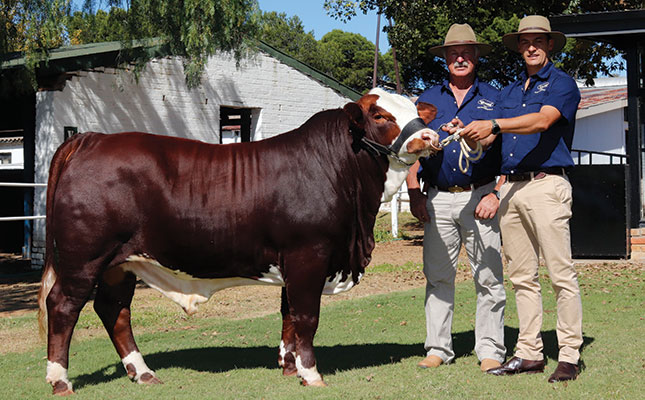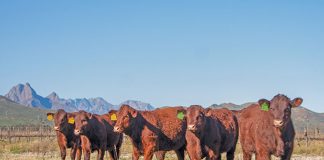
Photo: Wayne Southwood
In the past, Brafords have been called the best-kept secret in the beef cattle world. However, it’s not a secret that these medium-framed animals are among the most fertile cattle on the planet.
“Its medium frame means that the animal is able to recover from a harsh winter much quicker than an animal with a large frame. That is why it’s the ideal animal for the Mpumalanga Highveld,” says Gert van der Merwe, founder of Bonheur Brafords. “A stressed animal cannot ovulate, and that makes conception impossible.”
We’re sitting in his farmhouse just outside Bethal in Mpumalanga. Since the early 1980s, Van der Merwe, a qualified veterinary technician, has been farming on this piece of land. Prior to this, he was an agricultural counsellor for the former OTK (now Afgri).
Initially he started out as a dairy producer, but over the years the farm diversified into various commodity crops (maize and soya bean) and cover crops (silage and irrigated legumes). In itself this has become a noteworthy business.
Van der Merwe, in partnership with Barenbrug SA, processes and exports cover crop seeds to various countries around the world.
SWITCHING TO MEAT PRODUCTION
In 2002, he realised that the dairy’s finances no longer made business sense. According to his calculations at the time, milk could only be produced profitably from coastal pastures, a far cry from the dry highveld soil on which he toiled.
This forced him to rethink his business plan, and he shifted his focus to meat production, specifically of sheep and cattle.
Horses have also always been a strong component of the farm. His only daughter, Elri de Jager, inherited this passion. Not only did she shatter all previous records with her performance at the Western Mounted Games in Parys, Free State, last year, but she is also a polocrosse champion. It was at the local polocrosse club where she met her husband and Van der Merwe’s farming partner, Johan de Jager.
De Jager was not raised on a farm, but was born with a farmer’s heart. After playing rugby for the University of Pretoria for a few years, the young man from Middelburg, Mpumalanga, went to the US to work on a crop farm.
“In the less busy winter period I would help the neighbouring black Angus farmer during the farm’s calving season,” says De Jager. “The cows would calve in the snow, and the calves would be put on a trailer and be brought into a barn. The mothers would follow, and therefore the chances of hypothermia would be reduced.”
After his stint in the US, De Jager returned to South Africa and became a fertiliser salesman, and also met Elri.
Today, De Jager is mostly in charge of livestock, while Van der Merwe oversees the cropping part of the business. The enterprise covers 1 500ha of land. Some of this is owned by the family, while other parts are rented.
The land is situated at 1 660m above sea level, and the soil types vary from turf to sandy. Water is drawn from boreholes, while a farm on the dam provides water for irrigation.
“I am steadily handing over the reins, but I’m not planning to ever fully retire. I’ll probably remain on the farm and still be part of the business in an advisory capacity,” says Van der Merwe.
BREEDING TOP GENETICS
Van der Merwe says the decision to start a Braford stud was easy because of the heterosis of the breed. This is the result of crossbreeding a Brahman (Bos indicus) with a Hereford (B. taurus).
The cross between these breeds has resulted in an animal that is more than the sum of its parts.
From the Brahman genetics, the Braford has inherited longevity, a smooth skin and good walking ability. From the Hereford, it has inherited ease of calving, high fertility, and a great frame for meat production. The Bonheur stud was registered with BreedPlan in 2013 and currently consists of 566 registered animals.
“We only have a single calving season,” says De Jager. This stretches from May to September, which might seem long, but is due to the fact that they bought in animals from various breeders.
“We’re trying to shorten the breeding period by two weeks per year to rectify this issue over time.”
They bought top genetics from various breeders to expand their stud’s gene pool as broadly as possible.
Top semen was also imported from Australia to enhance the gene pool even further.
The industry seems to agree with the Bonheur breeding plan, as one of the stud’s bulls was sold for a record-high price of R200 000 at their previous production auction in 2021. Their next production auction will be held on 22 June at the Polocrosse Club in Bethal.
One of the main distinguishable qualities of this breed is that Braford heifers are generally ready for conception at an earlier age than other breeds’ heifers, and normally give birth to their first calf at around 28 months.
“Once an animal has reached 340kg, it will be artificially inseminated,” says Van der Merwe.
This means that the heifer will calf when it has reached 80% of its adult weight of 480kg to 500kg.
However, once the first calving is completed, the new mother will be given an additional month for recovery before breeding again. Van der Merwe says this is done because reconception, rather than initial conception, is the trickiest part when it comes to successful breeding.
In terms of the inter-calving period, Van der Merwe and De Jager strive for every cow to produce a calf every year.
Calves are weaned at between six and seven months. By then they have gained 45% to 50% of their mother’s body weight. “This translates into an average weaning weight of 225kg for heifers and 235kg for bulls across the stud,” says Van der Merwe.
COMMERCIAL SUCCESS
De Jager says one of the Braford’s best genetic traits is its feed conversion rate.
The US’s National Center for Biotechnology Information has calculated that at optimal levels, an 18- to 20-month-old Braford ox should have an average daily weight gain of 2,45kg, with a feed conversion ratio of 5,3:1. In other words, for every kilogram of beef produced, the ox consumes 5,3kg of feed.
This makes it a very sought-after breed in feedlots, says De Jager. To ensure that Bonheur remains competitive, they partake annually in a 126-day Phase C test at Sernick.
In May 2022, Bonheur’s Braford bull GM 20 043 achieved Gold Merit at Vleissentraal/SA Stud Book’s Elite Bull Growth Test at the Bloem Show.
Brafords not only achieve wonderful results in feedlots, but are able to perform well on pastures as well, says De Jager.
“This breed also has excellent marbling and delivers top-quality meat.”
BIOSECURITY AND DISEASE PREVENTION
No farmer can successfully farm without a proper biosecurity plan. Despite being trained as a veterinary technician, Van der Merwe still consulted a veterinarian to draw up a biosecurity plan for the farm. Veterinarians are also crucial to the screening process to find out which cows are in calf and to determine if there are any abnormalities.
“Veterinarians simply offer a more comprehensive service, and you know quickly if anything is wrong,” De Jager explains.
Furthermore, the Bonheur breeders take traceability very seriously. No animal is moved onto or from the farm without the necessary inspections being made.
They have also invested in radio frequency identification equipment this year to make pasture-to-plate traceability easier.
“Once you are armed with the correct information, it becomes easier to know which animals to get rid of,” says De Jager, while Van der Merwe adds proudly: “Johan is a very focused farmer. He makes decisions with his head and does not let his heart interfere!”
Email Johan de Jager at [email protected].












